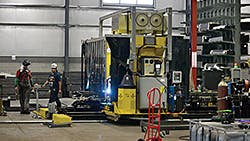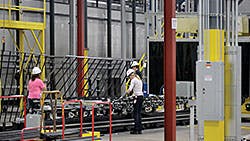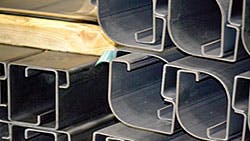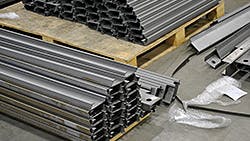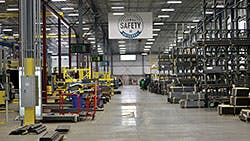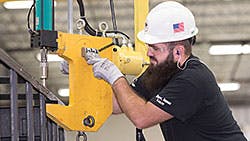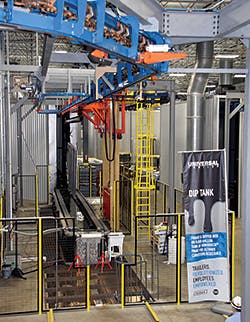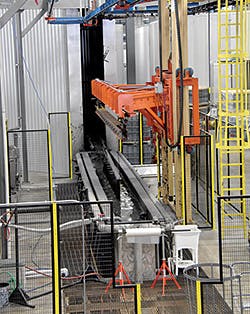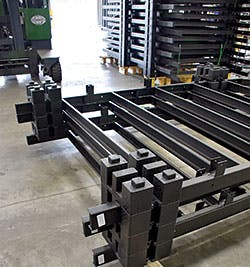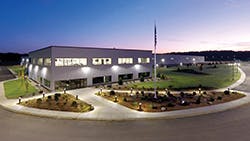Universal Trailer introduces a new concept in multi-plant trailer production
Hub and spoke. Airlines use it to improve efficiency of the routes they fly. Now a major manufacturer of light- and medium-duty trailers is using it to do the same thing in the trailer business.
For airlines, the idea is simple: Commuter flights fly passengers into a central airport that is the hub of the airline’s operations. From there, they fly to any of a wide number of other destinations. For Universal Trailer, the concept works somewhat similarly. But in the trailer business, it does even more.
Universal Trailer held a grand opening for its new hub March 24. Much like the commuter airlines do, trailer suppliers feed the new hub with the components required to produce trailers up to 24 feet long. Some of those components are assembled into finished trailers and (like a nonstop flight) go straight to the dealer or customer.
But more interesting is what else the 200,000-sq-ft facility does. It stops short of completing the trailer and instead builds trailer kits that are shipped to other Universal Trailer facilities across the country. Wells Cargo and Haulmark trailers will be produced as complete trailer frame kits, which will then be shipped to Universal Trailer’s four cargo trailer facilities around the country for further assembly and customization. The company operates facilities in McAdoo, Pennsylvania; Ogden, Utah; and Waco, Texas in addition to plants in northern Indiana.
“The idea is very scalable,” says Scott Samuels, director of marketing for Universal Trailer’s Cargo Group. “If we open a manufacturing facility in the Southeast, the plant here has the capacity to handle it. We produce kits here and ship them to the new location. The new location essentially serves as an assembly facility, which we can open at less cost than if we chose to operate a string of self-sufficient manufacturing plants. The modular production process enables us to meet global market demands, producing twice as many Haulmark and Wells Cargo trailers per week vs. the traditional production methods used, all the while keeping our quality high. For us, this is a completely new business model.”
The new Bristol plant supplies kits that consist of chassis, walls, and roof. And the fixtures used to build those components are designed to be capable of a wide range of heights, widths, and lengths.
“Our trailers range in wide from four feet wide to 102 inches,” Samuels says. “and the trailers we build here are up to 24 feet long. Universal Trailer builds some very high-spec trailers such as living quarters trailers elsewhere in the company, but that’s not what this plant is designed to do. We built it to handle our high-volume products.”
The most obvious prerequisite for a hub and spoke system to work is to have multiple plants. Universal Trailer has that—in spades. Since its start in 2001, the Fort Myers, Florida, company has acquired some of the leading manufacturers in the light- and medium-duty trailer industry. Exiss Aluminum Trailers of El Reno, Oklahoma, was the first acquisition, followed in 2002 by Haulmark Industries, headquartered in Bristol, Indiana. Other brands soon followed: Sooner Trailer Manufacturing Company of Duncan, Oklahoma; Featherlite of Cresco, Iowa; and Wells Cargo of Elkhart, Indiana in 2009.
Products include trailers for hauling horses and other livestock, ATV trailers, motorcycles, snowmobiles, racecars, equipment, and cargo.
Close to home
Although Universal Trailer is headquartered in Fort Myers, Florida, some of the manufacturers that the 16-year-old company has have been around much longer and have established much deeper roots. That is especially the case with the Haulmark and Wells Cargo brands, both of whom operate facilities in and around Bristol, Indiana.
“We wanted to stay in the area,” Samuels says. “This is where our workers and our suppliers are.”
We can illustrate that statement by pointing out that many of the company’s suppliers also serve recreational and motor home manufacturers. Northern Indiana is the epicenter of this industry. The RV/MH Hall of Fame is located between the Wells Cargo plant in Elkhart and the new facility in Bristol. With only 12 miles separating the two facilities, Universal Trailer could build in Bristol without substantially affecting the commute of existing employees. That is particularly true for those employed at the Haulmark plant that Universal Trailer continues to operate.
“We find ourselves talking about the ‘Wells Cargo’ plant or the ‘Haulmark plant,’ but they are all Universal Trailer plants,” Samuels says. “That’s especially true now that we have one plant that serves them.”
Biggest investment
The facility represents a significant investment—approximately $25 million in brick and mortar, plus almost three years of engineering.
“This plant is by far the biggest investment I have seen in my 25 years in the cargo trailer business,” Samuels says.
Located on 43 acres, the 200,000-sq-ft building provides 175,000 square feet of production space and houses 25,000 square feet of offices.
“We built this plant to change the industry,” Samuels says. “We wanted better materials, including expanded use of high-strength, low alloy steels. Improved corrosion resistance, and a greater use of automotive processes such as robotic welding. We wanted to up our game on corrosion resistance. And we wanted to bring our paint and welding under one roof.”
One wall of the building can be knocked out to provide additional room for assembly when needed. And given its role as the fabrication “hub” for Universal Trailers, the fabrication functions were given sufficient capacity to serve the company’s other facilities now and in the foreseeable future.
Two of the key features of the plant are its robotic welding operation and an advanced paint system that features a computer controlled conveyor system that transports trailer assemblies through a series of dip tanks and automated cleaning and drying operations.
Robotic welding
Three gantry-style robots perform most of the welding of what Universal Trailer calls “the shark cage”—the steel framework to which the walls, floor, and roof are secured. They operate in a series of three cells, each assigned to a specific component of the shark cage. The cells are configured so that one side of the cell can be loaded or unloaded while the robot welds the other.
Each robotic welding cell has a specific responsibility. The chassis and roof are welded in one cell. A second cell produces the rear and front, along with the curbside wall. The third cell welds ramp doors and the roadside wall.
Why does this matter? Dividing the workload in this manner enables the cycle times for each of the three welding cells to match, which keeps work flowing smoothly.
Universal Trailer engineers gave considerable thought to the jigs that hold pieces in place during the welding process—and the parts that are placed on those jigs. If the dimensions of the parts are out of tolerance, they don’t fit on the jigs. “We no longer are able to use parts that are formed on a press brake. The tolerances are not precise enough,” Samuels says. “We need the precision that we get from roll-formed parts.”
The two major components of the plant—robotic welding and the paint system are tied together by an overhead conveyor system. After each component of the trailer’s steel frame is unloaded off the robotic welding cell, it is loaded onto the conveyor for a trip through the multi-stage paint line.
Automated paint line
The automotive-style paint line includes a special pre-wash, rinse, an 8,000-gallon dip tank, drying oven, cooling tunnel, and booth for the spray-on top coat.
The focal point of the process is corrosion protection. Universal Trailer uses AquaGuard, an advanced protective coating from Valspar. Universal Trailer considers the coating to be environmentally friendly and proven, through laboratory testing, to deliver real-world protection against rust creep.
Steel assemblies are loaded onto one of 65 load bars on the automated overhead conveyor system. Along the way, the assemblies are transported through two prewash tunnels, two rinse tunnels, VOC flash tunnel, and a dry-off oven.
The culmination of the line, of course, is the dip tank. The coating circulates continuously in the tank. The system also is designed to keep the coating within the desired temperature range and to maintain the desired level of the tank.
Redesigned trailers
Universal Trailer also has redesigned its trailers with proprietary shapes—U-posts, G-posts, double-flange crossmembers, all of which help Universal Trailer manage strength and weight.
“We got pretty creative,” Samuels says. “Our engineers designed the shapes that we use in our trailers.”
All of these shapes are roll-formed from a variety of gauges of steel. Universal Trailer bought the tooling, and an outside company roll-forms the shapes.
The newly designed trailers are engineered to last three times longer than previous designs, yet they are up to 14% lighter. “The larger the trailer, the greater the weight savings,” Samuels says.
“When we designed the trailer, we kept coming up with shapes and profiles that we could not produce with the standard press brake process,” says Jim Springsteen, lead design engineer. “Roll forming allows us to do something we were not able to do before—get longer material for longer trailers.”
Along with the new roll-formed parts comes new ways (at least for Universal) to secure them. Universal Trailer has begun using Huck BOM (blind oversized mechanically locked) fasteners which, according to Huck, will do the work of four conventional fasteners.
Universal Trailer also has begun to use the TOX automotive sheet metal fastening system to replace spot welding. The circular die of the TOX pneumatically powered crimping tool presses the two pieces together and then creates a flair at the bottom of the die stroke that holds the two pieces together.
Tortured on the test track
Extended life of the new designs are not unsubstantiated claims. The company contacted with a nearby automotive test track to perform durability testing.
To verify its new materials, production techniques, and fastening methods, Universal Trailer stress-tested its new cargo trailers design on commercial truck test tracks for over two years. The company also used 3D modeling and computer vibration simulation to further validate the new design.”
“This was a new design for us and, I think, for the industry,” Springsteen says. “We wanted to make sure that the design itself would be durable and would hold up for the customer.” ♦
About the Author
Bruce Sauer
Editor
Bruce Sauer has been writing about the truck trailer, truck body and truck equipment industries since joining Trailer/Body Builders as an associate editor in 1974. During his career at Trailer/Body Builders, he has served as the magazine's managing editor and executive editor before being named editor of the magazine in 1999. He holds a Bachelor of Journalism degree from the University of Texas at Austin.

